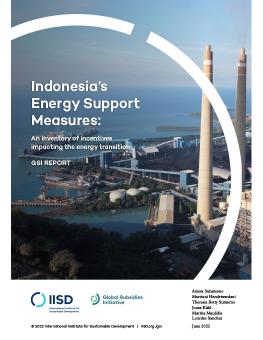
Indonesia’s Energy Support Measures: An inventory of incentives impacting the energy transition
Energy incentives and support measures can help Indonesia influence energy production and consumption in a way that meets its climate and energy targets. As the country has committed to reaching net-zero emissions by 2060, this inventory report of energy support measures in Indonesia explores whether the current fiscal policies are aligned with this goal. The first of its kind, the inventory identifies and quantifies support measures available for various energy types—including coal, oil and gas, renewable energy, biofuels, and electric vehicles—between 2016 and 2020.
-
The Indonesian government support for fossil fuels remains substantially higher than for renewable energy, with as much as 94% allocated on average each year to support coal, oil and gas, and fossil fuel-based electricity and just 1% allocated to renewable energy.
-
Energy support measures in Indonesia rose by 38% from IDR 203 trillion in 2016 to IDR 279 trillion in 2020, disproportionately benefiting the fossil fuels sector.
-
Estimated fossil fuel incentives in Indonesia increased by 30% between 2016 and 2020 to at least IDR 246 trillion, while support for renewable energy dropped from IDR 3 trillion in 2016 to IDR 2 trillion in 2020.
The report serves as a starting point for the Government of Indonesia, as well as all stakeholders, concerned citizens, and the wider public to “follow the money”: to track the flow of public funding and to understand how public money is being spent on different types of energy. Through data visualization of the flow and allocation of the support measures throughout the period observed, this report also aims to shed light on government spending on fossil fuels vis-à-vis renewable energy and clean technology.
The Government of Indonesia provides a range of energy support measures, incentives, and interventions that stimulate energy production and consumption, some of which are directed to support and protect the vulnerable segments of the population (e.g., poor households and small businesses). There are also other measures aiming to promote a transition toward clean and renewable energy, although, at present, government support is still predominantly addressed to the fossil fuels sector.
Overall, 77% (60 measures out of 78) of the support measures identified in the report were for the benefit of energy producers. Only 20% of all measures were given to support consumers, and the rest of the measures were provided to benefit both producers and consumers.
Support for fossil fuels and fossil fuel-generated electricity also remains substantially higher than for renewable energy, undermining the effort to achieve 23% of renewable sources in the energy mix by 2025 and net-zero carbon emissions by 2060.
Fossil fuel support drains the public budget, particularly in the current context of high energy prices. Support for fossil fuels is coming at a high cost to Indonesia’s public finances, and it is slowing Indonesia’s energy transition in two ways: 1) it locks in fossil fuel production, leading to ongoing fossil fuel dependence; and 2) by lowering the price of fossil fuels and fossil-sourced electricity, it makes it harder for renewables to compete.
Given its nationally determined contribution to the United Nations Framework Convention on Climate Change as well as its renewable energy targets, it would be reasonable for Indonesia to focus more on creating effective incentive mechanisms to further promote the adoption and development of renewable energy. Shifting or reallocating support from fossil fuels to renewable energy would be a good start.
Notes:
- To select multiple categories, hold the Ctrl key and select the desired category.
- The fiscal year for the State Budget of the Government of Indonesia starts in January and ends in December.
- Type of support measure*: Based on SDG indicator 12.c.1 (Measuring Fossil Fuel Subsidies in the Context of the Sustainable Development Goals | UNEP - UN Environment Programme)
Participating experts
You might also be interested in
Indonesia’s Energy Support Measures Hit IDR 279 Trillion in FY 2020 Disproportionately Benefitting Fossil Fuels
Energy support measures in Indonesia hit IDR 279 trillion in FY 2020, of which a staggering 88% was allocated to fossil fuels, according to a new report from IISD.
COP27 diary (November 16): '$100 billion in climate finance more of gesture from rich countries'
The 27th Conference of Parties (COP27) to the United Nations Framework Convention on Climate Change in Sharm El-Sheikh, Egypt, began November 7, 2022. Here’s a look at what happened on day 10 of COP27 climate talks. The draft text for a cover decision is yet to be produced by the COP27 Presidency as of 7.30 am November 17, leading many to wonder how long discussions will continue to arrive at a consensus on the document once released. Just two days of the summit remain.
Just Energy Transition Partnerships: An opportunity to leapfrog from coal to clean energy
One year on from the announcement of the first "Just Energy Transition Partnership" (JETP) at the 26th UN Climate Change Conference of the Parties (COP 26) in Glasgow, what have we learned and where are these innovative funding models headed?
Indonesia's JETP Deal Will Only Succeed if Coupled with Radical Measures to Unblock Renewable Energy Pipeline
At the G20 Summit in Bali, a group of developed countries—led by the United States of America and Japan—pledged to mobilize US$20 billion (around Rp300 trillion) over the next 3-5 years to accelerate Indonesia’s energy transition through early retirement of coal power plants and deployment of renewable energy. The flood of new finance for renewable energy under the so-called Just Energy Transition Partnership agreement (JETP) is certainly welcome—but unless the critical barriers to renewable energy deployment in Indonesia are addressed, the deal will fail to deliver.